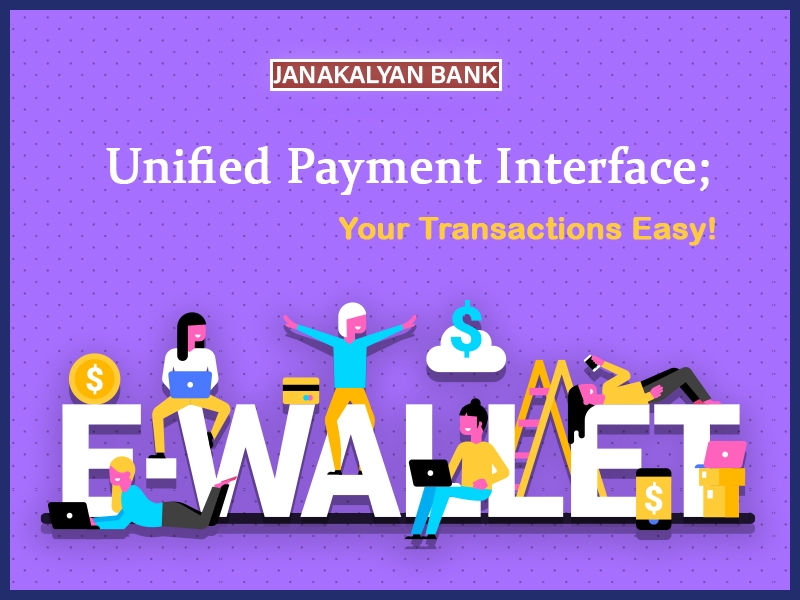Unified Payment Interface(UPI); Make your transactions easy
|

Unified Payment Interface - UPI
Our lives have drastically changed, owing to the Covid-19 pandemic, where the world is still trying to get over the dark year which is still far from over! With the advancement in technology and people accepting digitization, the gradual transition from manual to digital was quite appealing. The major impact was on the banking sector where people welcomed processing transactions online. While a lot has been said about E-Wallets and other digital payment options, this blog will try to unveil what are Unified Payment Interface (UPI) and its benefits.
Unified Payment Interface (UPI) is a single platform where you can merge various bank services and features under one umbrella. The new payment model allows you to use your smartphones as a virtual debit card. It has also made possible the sending and receiving of money instantly. The concept of QR code has eliminated the usage of digital wallets altogether.
The UPI was a part of Green Initiative to decrease the usage of paper in domestic payment market. Officially launched in 2016 for public use,. It has become the world’s largest real-time payment market with ₹ 25.5 billion annual transaction in 2020, leaving behind China and the United States. UPI touched value of ₹7.71 trillion in October 2021 which is 56% jump from September. As per NPCI, daily UPI payment for the month of October is between ₹250 to ₹300 billion.
What is UPI?
Unified Payments Interface is an instant and immediate real-time payment system which helps to transfer the funds between two bank accounts through your mobile phone. UPI allows you to link multiple bank accounts to your phone at one go! Conceptualized and developed by the National Payments Corporation of India (NPCI), UPI is controlled by the RBI and IBA (Indian Bank Association).
UPI is based on 2 Factor Authentication with single click payment. It is also aligned with the regulatory guideline that makes it even safer to use. All thanks to the double factor authentication that works similar to OTP, but here we use our MPIN instead of OTP.
How Does UPI Work?
The Virtual Payment Address or VPA that you create and link to your bank account becomes the user’s financial address. So now, you don’t worry of remembering someone’s detail like their beneficiary account number, IFSC codes, or net banking user id and password for sending or receiving money. This VPA address will now work as an additional security and make things feasible for transactions thereafter.
Services offered by UPI:
There are numerous features offered by UPI. A user can access his/her balances and transaction histories along with sending and receiving money. One can instantly transfer funds immediately through IMPS which is faster than NEFT. And since using UPI is completely digital, one can use this 24 hours anytime and even on all public holidays.
The money can be sent or requested by using user created Virtual Payment Address (VPA) or UPI ID that helps in sending or requesting money from bank account using the know your customer (KYC) linked mobile number. UPI also generates specific QR code for each user account for the purpose of contact-less payment.
Benefits of UPI:
• Fund transfers or payments are free of cost.
• Transactions happen instantly 24*7 on all days including bank holidays.
• If any disruptions or disparities, complaints can be raised through mobile apps themselves.
• A single UPI app can be connected to multiple bank accounts.
• Neither the payee nor the beneficiary is required to share their bank details. Transactions happen through a VPA ensuring complete privacy.
• Perfect for small or large money transfers with a daily cap of Rs.1 lac.
• UPI apps are attractive with their rewards and cashback systems.
Apps allowing UPI usage
There are many apps coming up every day that supports UPI payments, such as Google Pay, PhonePe, FreeCharge, Mobikwik, and others. You need to verify your bank account information to generate UPI ID on the app before you begin transactions.
NPCI envisions to internationalize digital payment services like UPI, RuPay and BHIM, and are in talks with UAE and Singapore to operate UPI in their respective countries as there are a sizable Indian expatriates and for easy payment for Indian tourists travelling abroad. It is planning to link UPI with standalone mobile wallets so that users can transfer money from one provider to another one which till now is restricted due to use of closed source technology.
Internationally, Bhutan was the first country to accept UPI transactions through BHIM App. Spreading its presence all across the globe, UPI will be available in Singapore, Malaysia, Thailand, Philippines, Vietnam, Cambodia, Hong Kong, Taiwan, South Korea, and Japan from 2022. From 21 banks in April 2016, the total number of banks linked to UPI platform is 216, as of April 2020.